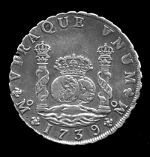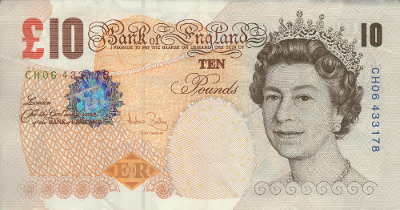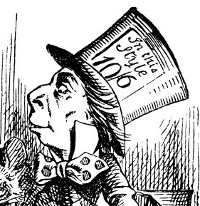Dollars
How much does it cost for a shave and a haircut? Two bits! But when was the last time a bit was legal tender? I’ve seen two dollar bills but I’ve never seen a bit. A bit is actually a remnant of America’s old money from before they invented their own currency. It is one eighth of a dollar, so two bits are a quarter. You can get one two-bit coin, but you can’t get two one-bit coins. So what’s a dollar, then? And why should it be divisible by eight, the least popular of all numbers in the history of the universe? The answer is: pirate money.
In the heady days of expansion and empire, before the old West and before the American Revolution, there was a coin called the dollar. It was a silver Spanish coin properly called a peso, but because it was worth eight reales they were also called pieces of eight — the same pieces of eight that get pirates all hot and bothered. “Yarrgh, pieces of eight, cat o’ nine tails, swashbuckle me barnacles, etc.” Those pieces of eight were like catnip to pirates because they were made from silver and could easily be traded or melted down. The Americas were awash in pieces of eight. The American colonies had a shortage of British currency and they were trading regularly with the West Indies, so they simply minted their own pieces of eight. These Spanish dollars were the international currency of the 18th century.

In 1792 the newly minted United States of America issued their first American coins. They named them dollars after the Spanish coins, which remained in circulation until they stopped being legal tender in 1857. As well as clinging to the word “dollar”, the Americans retained the word “bit” as an anachronism in memory of the old real. With no actual one-bit coin, Americans sometimes called a dime a “short bit” and 15¢ a “long bit”. There’s even some speculation that the dollar sign $ represents the column and scroll on the front of a piece of eight.
This makes a great story, but still doesn’t shed much light on where the word “dollar” originally came from. Everyone can see that “cent” means 100, but the word “dollar” is a bit more obscure. Turns out it’s a place name. The Spanish dollar borrowed its name from a German coin called the thaler, with which Spain was trying to compete. The Germans got their word thaler from the Joachimstaler, a coin minted from Joachimsthal in Bohemia in the early 16th century. So there you have it — our dollars come from an obscure silver mine in Bohemia by way of pirates and haircuts. It’s hard to expect more than that from a chunk of metal that has faces on it.
Pounds Sterling

While Americans have largely shed the remnants of the old piece of eight, the British have some very visible left-overs from their old currency. Pick up any note in Britain and you’ll see something curious written next to the Queen’s big, gormless face: “I promise to pay the bearer on demand the sum of Ten Pounds”, followed by the signature of the Chief Cashier of the Bank of England. The question is, if you’re not already holding ten pounds, then what would you get ten pounds of if you went to the bank and asked for it? Turns out, it’s gold.
Or rather, it would have been gold if Britain were still on the gold standard. The wording on pound notes dates from the 19th century when Britain officially valued their currency relative to the value of gold. Before that the currency had actually been minted from real gold, and before that the currency was minted from silver. When the currency was invented in 8th century England, pennies (also known as sterlings) were made of silver and a pound was a unit of currency equal to 240 sterlings or one pound of silver. A modern pound sterling used to be exactly that — a pound of silver by weight.
Britain’s currency has since detached from the silver and gold standards, but it did undergo another wonderful process. It became decimalized. One of the (few) things Doctor Who successfully predicted was the decimalization of British currency, but prior to 1971 British currency was what I would politely call a catastrophe in the kitty-litter tray. There were four farthings in a penny, twelve pence in a shilling, and 20 shillings in a pound. Then there were other coins, totally unrelated to any kind of increasing scale of units. A florin was two shillings, a crown was five shillings, and a guinea was a pound and a shilling. Didn’t I say it was unholy? Is it any wonder the British lost their empire? They spent all their damn time figuring out how much change you get back from a cup of coffee. Americans, take note. 5,280 feet in a mile is not a tenable system.

What’s more, the abbreviations for British currency were not anything remotely sensible. Often you would just get a slash, indicating shillings and pence, like in the Mad Hatter’s advertisement “In this style 10/6” (i.e. ten shillings and sixpence). The abbreviation for pounds was and still is £, derived from a capital L for librae, a Roman unit of weight. The abbreviation for shillings was s. for solidi and pence were d. for denarii, which were both Roman coins. Perfectly sensible, if you are certifiably insane. For any 60s psych-rockers who like the Bonzo Dog Doo-Dah Band as much as I do, you might remember the opening lines from “Ali Baba’s Camel”:
You’ve heard of Ali Baba,
Forty thieves had he,
Out for what we all want,
Lots of LSD!
It took me years to understand that “LSD” didn’t actually mean the drug, but £, s., and d. — pounds, shillings and pence.
An Invitation to Trouble
I’ve covered American dollars and British pounds. But there are thousands of currencies out there. Got a weird one? Esperanto steloj? Wooden dollars? Vietnamese dongs?! Send it my way and I’ll be delighted to look it up. As with everything on this blog, always remember: the stupider, the better.